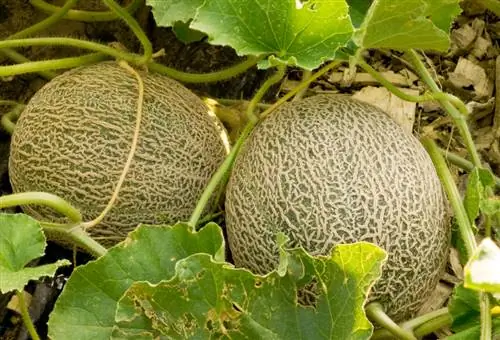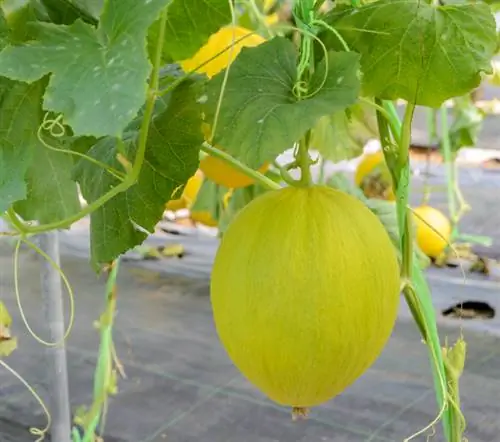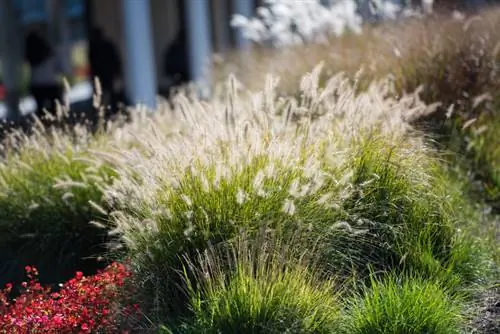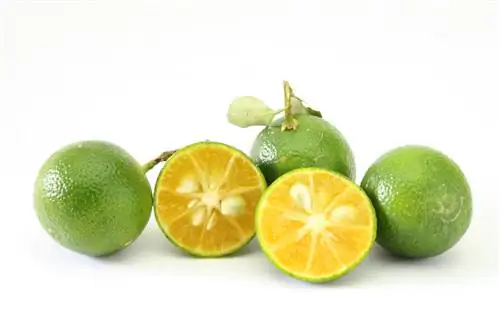- Author admin [email protected].
- Public 2023-12-16 16:46.
- Last modified 2025-01-23 11:20.
Sugarmelons and watermelons botanically belong to the group of cucurbits (Cucurbitaceae). However, muskmelons (Cucumis melo) are botanically more closely related to cucumbers than to the watermelon family (Citrullus lanatus).

What types of melons are there?
There are different types of melons, mainly divided into watermelons and muskmelons. The muskmelons include honeydew melons, winter melons, net melons and cantaloupe melons. Well-known types of watermelon are Crimson Sweet and Sugar Baby.
Origin and distribution of melons
Basically, according to botanists, the origin of all melon species can be found somewhere on the African continent. Today, the so-called Tsamma melon is generally considered to be an original form of watermelon, some of whose representatives can still be found today as wild plants in various areas of Africa. The fact that the fruits of these plants have a relatively bitter pulp and many large seeds is the reason why melons are so widespread around the world today. After all, in earlier centuries the fruits were used by seafarers as provisions with a limited shelf life, as the seeds could be eaten roasted or flour could be made from them. After an early spread in Egypt, Persia and Asia Minor, melons also reached the following countries:
- North America
- Central and South America
- East Asia
Basic requirements for planting and caring for melons
When growing melons in your own garden or greenhouse, you should pay attention to the plants' heat and fluid needs. Since many types of melon are grown in tropical and subtropical temperatures in southern countries, you should ensure that the location in this country is as full of sun and protected from the wind as possible. In addition, the soil should not be too calcareous and should be as permeable as possible so that the sensitive roots do not become waterlogged.
Preferring melons in the house
Actually all types of melon should be preferred for cultivation in Central Europe on the windowsill or in a greenhouse so that the short summer season can be used as best as possible for caring for the plants right up to harvesting fully ripe fruits. To do this, simply put two to three seeds in a small pot. You can save yourself a lot of trouble with dying young plants if you sow the seeds straight away in rotting plant pots. In this way, you save the sensitive roots a critical point in their development by eliminating the need for pricking. Planting should only take place from around mid-May, as young melon plants are very sensitive to night frosts. In full sunny weather, it is also advisable to first let the plants grown indoors get used to the bright sunlight for a few hours at a time.
Overview of different types of melons
Basically, a distinction is made between watermelons and sugar melons. Since some types of sugar melon, such as the Charentais melon, only produce fruits about the size of a fist, they are sometimes also suitable for growing on the balcony.
The watermelon and its special features
Among the different types of melon, the watermelon is one of the melons that are particularly often grown outdoors, in pots or in greenhouses in this country. While the large Crimson Sweet variety with its fruits weighing up to 15 kilograms is suitable for growing on sunny slopes, the smaller and aromatically sweet Dugar Baby can also be grown on the balcony or in the greenhouse.
Around the honeydew melon
The honeydew melon is sometimes also known as the “yellow canary” due to one of its main growing regions and its bright, vibrant color. Fully ripe fruits exude a slightly sweet scent, which should not be too overpowering, otherwise it is an overripe specimen. In addition to the Canary Islands, the honeydew melon is also grown in the following countries of origin:
- Iran
- China
- Brazil
Like all types of melon, the fruits have a limited shelf life and are often served with ham as an appetizer.
More muskmelons and their properties
The sugar melons are basically divided into three groups, with the winter melon group being characterized by the fact that their fruits do not ripen after the harvest. Winter melons include melon varieties such as the Yellow Canary, Tendral and Piel de Sapo. Net melons, on the other hand, continue to ripen a little after harvest and are characterized by an aromatic scent. Net melons include melon varieties such as Honey Dew or the extremely popular Galia melon. The third subdivision of sugar melons is the so-called cantaloupe melons; in addition to the well-known Charentais cultivar from southern France, this also includes the plants and fruits of the Ogen subspecies. All sugar melons usually last about three to seven days in the refrigerator when cut. However, due to their smaller size, muskmelons are usually easier to use than watermelons.
Tips & Tricks
In principle, young plants can be grown on the windowsill or in your own garden from the seeds of most commercially available melon varieties. However, these seeds must first be cleaned of any pulp so that they do not become moldy before or during the germination phase.






